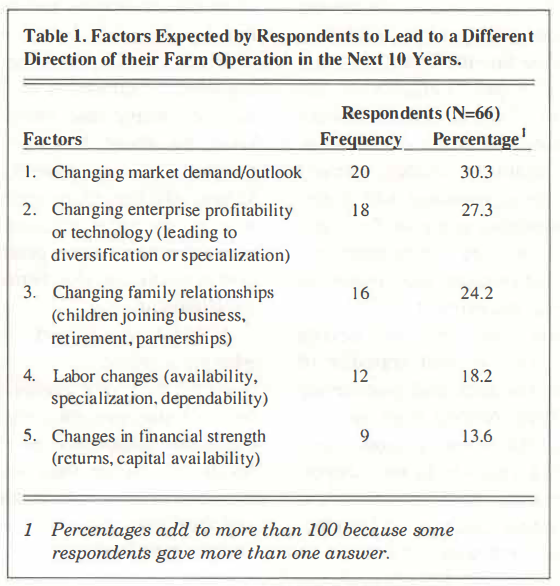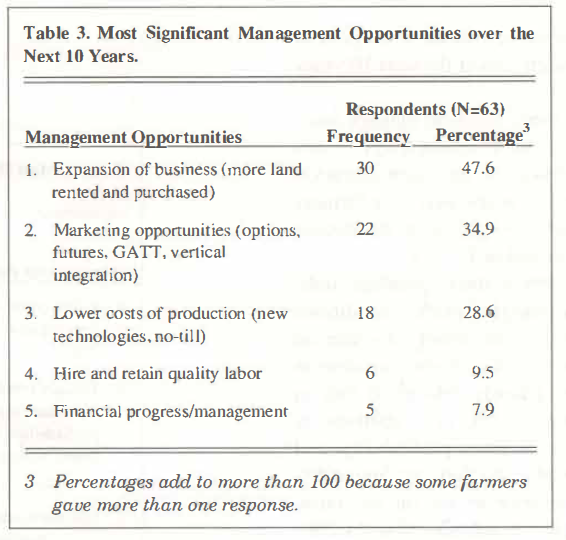Farm Decision-Makers’ View of the Future
March 16, 1992
PAER-1992-5
Gerald Ortman, Visiting Associate Professor; George Patrick, Professor; and Howard Doster, Associate Professor
Farmers operate in an uncertain environment characterized by variable weather conditions, changing prices, advancing technology, changing government policies, and changing international trends. Many farmers expect less government support in the future and thus will bear more risks themselves. Therefore, demand will increase for information that will help farmers make better decisions.
More than 80 principal farm decision-makers who attended the 1991 Top Farmer Crop Workshop at Purdue were surveyed on many topics, including the following looks to the future:
- the factors they expected would alter their farm’s direction in the next 10 years
- their most difficult management problems over the next 10 years
- their most significant management opportunities over the next 10 years

Table 1. Factors Expected by Respondents to Lead to a Different Direction of their Farm Operation in the Next 10 Years
These farm decision-makers were asked what factors might lead to a different direction for their farm operation in the next 10 years. Sixty-six farmers responded to this question. Responses are summarized in Table l.
About 30% of the respondents indicated that changing market conditions would have an important influence on the direction of their faro, operation in the future. Closely related to this in importance, 27.3% of responses, is changing enterprise profitability and the effects of technology leading to different enterprise mixes on the farm. Changing family relationships (24.2%), labor changes (availability, dependability) (18.2%), as well as changes in financial strength (13.6%) are factors expected to influence the direction of business in a significant way. In addition, adverse weather and risk, government programs, and environmental issues were seen as impo11ant factors by some famers (but these are not shown in Table 1).

Table 2. Most Difficult Management Problems over the Next 10 Years
The most difficult management problems over the next 10 years, as given by the respondents, are reported in Table 2. Seventy-two farmers answered the question, many giving more than one management problem.
Issues regarding the hiring, training, and keeping of quality employees (the management of labor) were of concern to nearly one-third of the respondents. Problems regarding finance, namely obtaining capital, reducing debt, maintaining profitability and cash flow, and where to invest, were seen as important by 29% of the farmers. Environmental issues were prominent (22.2% of respondents), as were marketing problems (I 6. 7%) and transfer of property to children and partnership issues (13.9%). Among responses not included in Table 2, the question of land expansion (11.1 % ) was the most important. Concerns with government programs and bureaucracy, and producing at a low cost were of concern to 9.7% and 6.9% of the respondents, respectively. Weather variability, mastering no-till, and personal time management were also indicated as important by some farmers.
The most significant management opportunities over the next 10 years, as viewed by the respondents, are reported in Table 3. Sixty-three farmers answered this question, many providing more than one response. Nearly onehalf of the respondents indicated that a significant management opportunity in the next 10 years is to expand the business by either renting or buying more land. Some respondents pointed out that the average age of the U.S. farmer is relatively high and increasing, so that there will be many opportunities to expand the land base by renting or buying land from retiring farmers. One of the objectives is to take advantage of economies of size, that is, to spread fixed costs over more units of output. About 29% of the respondents mentioned lowering unit costs (increasing efficiency or productivity) with the use of new technologies and no-till operations.
Marketing opportunities were also regarded as important by 35% of the farmers, hiring and retaining quality labor by about I 0%, and financial progress and management by 8%. In a sense, all the management opportunities that were indicated combine to make farmers more productive and competitive in the future farming environment.
In conclusion, farm decision-makers who participated in this study could be regarded as above-average farmers in terms of management ability – 80% of them use computers, their education levels are higher than average, their farm businesses are larger than average, and they view their own management abilities (although subjective) as above- average. Because these farmers will probably survive in the future, results of this survey may be of interest to other farmers, university researchers, the extension service, other government agriculture departments, and private consultants and institutions advising farmers.
The survey also contains information about the types of business arrangements among these progressive farmers, gross farm sales, debt-to-asset ratios, ratings of various information sources, needs regarding computer services, main sources of risk, responses to risk, and off-farm activities.

Table 3. Most Significant Management Opportunities over the Next 10 Years
